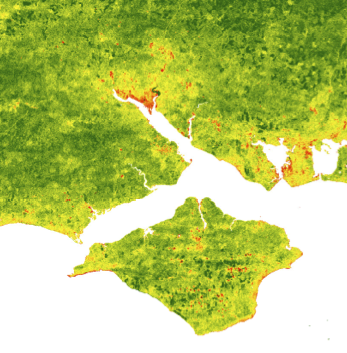Robin Wilson
Remote sensing academic

PhD
I completed my PhD in February 2015 at the University of Southampton. My thesis was entitled Developing a novel method to retrieve high spatial resolution Aerosol Optical Thickness (AOT) from satellite data. It is available for download here in PDF format (74Mb). The abstract, and high-resolution versions of some key images from the thesis, are below.
Abstract
Aerosol Optical Thickness (AOT) data has many important applications including atmospheric correction of satellite imagery and monitoring of particulate matter air pollution. Current data products are generally available at a kilometre-scale resolution, but many applications require far higher resolutions. For example, particulate matter concentrations vary on a metre-scale, and thus data products at a similar scale are required to provide accurate assessments of particle densities and allow effective monitoring of air quality and analysis of local air quality effects on health.
Similarly, atmospheric correction of satellite images requires a knowledge of the AOT over the image. Many atmospheric correction techniques assume a constant AOT across the whole image, but this is rarely (if ever) the case. Use of my new method should allow the AOT of high-resolution images (such as Landsat) to be retrieved for every pixel in the image, and thus used in a spatially-variable correction.
My novel method will retrieve per-pixel AOT values from high-resolution (~30m) satellite data. The method will be designed to work over a wide range of land covers – including both bright and dark surfaces - and requires only standard visible and near-infrared data, making it applicable to a range of data from sensors such as Landsat, DMC, SPOT and Pleiades. The method will be based upon an extension of the Haze Optimized Transform (HOT). The HOT was originally designed for assessing areas of thick haze in satellite imagery by calculating a ‘haziness’ value for each pixel in an image as the distance from a ‘Clear Line’ in feature space, defined by the high correlation between visible bands. Here, I will adapt the HOT method and use it to provide AOT data instead. Significant extensions include Monte Carlo estimation of the ‘Clear Line’, object-based correction for land cover, and estimation of the AOT values through Radiative Transfer Modelling.
This novel method will enable many new applications of AOT data that were impossible with previously available low-resolution data, and has the potential to contribute significantly to our understanding of the air quality on health, the accuracy of satellite image atmospheric correction and the role of aerosols in the climate system.